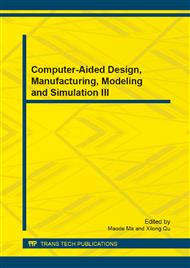p.123
p.129
p.137
p.141
p.145
p.150
p.155
p.160
p.164
Hydrodynamics Analysis Based on Improved VBF SPH Model
Abstract:
To improve the application of Smoothed Particle Hydrodynamics (SPH) method, a new Visual Basic-Fortran (VBF) SPH model with the improvements on efficiency and visualizable interface is presented. The VBF SPH model is based on mixed language programming (MLP) method that not only improved SPH model’s efficiency, but also created the interface functions to control and observe the whole simulation. İts general structrue is to compiling the Fortran computing subroutines into Dynamic Link Library (DLL) files and these files will be called by Visual Basic (VB) programs during the calculation. Besides that an improved link-list algorithm, is described detailedly. This algorithm improves the model’s searching efficiency by reducing the number of searching cells. Two classical problems, Flood flow over Dam and Droplet-Impact, are chosen to analyze the VBF SPH model efficiency and distinguish the improvements’ effect. Both of problems are simulated respectively by VBF SPH model and VB model. According to first simulation VBF SPH model is more than 8 times faster than the VB model. And the second simulation refers that the MLP method increased about 7 times efficiency while the improved link-list algorithm increased more than 1 time.
Info:
Periodical:
Pages:
145-149
Citation:
Online since:
October 2013
Authors:
Price:
Сopyright:
© 2014 Trans Tech Publications Ltd. All Rights Reserved
Share:
Citation:


